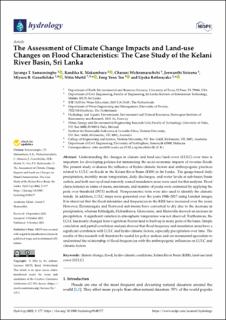| dc.contributor.author | Samarasinghe, Jayanga T. | |
| dc.contributor.author | Makumbura, Randika K. | |
| dc.contributor.author | Wickramarachchi, Charuni | |
| dc.contributor.author | Sirisena, Jeewanthi | |
| dc.contributor.author | Gunathilake, Miyuru | |
| dc.contributor.author | Muttil, Nitin | |
| dc.contributor.author | Teo, Fang Yenn | |
| dc.contributor.author | Rathnayake, Upaka | |
| dc.date.accessioned | 2022-12-30T09:39:59Z | |
| dc.date.available | 2022-12-30T09:39:59Z | |
| dc.date.created | 2022-11-28T14:46:48Z | |
| dc.date.issued | 2022-10-09 | |
| dc.identifier.citation | Hydrology. 2022, 9 (10), 1-18. | en_US |
| dc.identifier.issn | 2306-5338 | |
| dc.identifier.uri | https://hdl.handle.net/11250/3040037 | |
| dc.description.abstract | Understanding the changes in climate and land use/land cover (LULC) over time is important for developing policies for minimizing the socio-economic impacts of riverine floods. The present study evaluates the influence of hydro-climatic factors and anthropogenic practices related to LULC on floods in the Kelani River Basin (KRB) in Sri Lanka. The gauge-based daily precipitation, monthly mean temperature, daily discharges, and water levels at sub-basin/basin outlets, and both surveyed and remotely sensed inundation areas were used for this analysis. Flood characteristics in terms of mean, maximum, and number of peaks were estimated by applying the peak over threshold (POT) method. Nonparametric tests were also used to identify the climatic trends. In addition, LULC maps were generated over the years 1988–2017 using Landsat images. It is observed that the flood intensities and frequencies in the KRB have increased over the years. However, Deraniyagala and Norwood sub-basins have converted to dry due to the decrease in precipitation, whereas Kithulgala, Holombuwa, Glencourse, and Hanwella showed an increase in precipitation. A significant variation in atmospheric temperature was not observed. Furthermore, the LULC has mostly changed from vegetation/barren land to built-up in many parts of the basin. Simple correlation and partial correlation analysis showed that flood frequency and inundation areas have a significant correlation with LULC and hydro-climatic factors, especially precipitation over time. The results of this research will therefore be useful for policy makers and environmental specialists to understand the relationship of flood frequencies with the anthropogenic influences on LULC and climatic factors. | en_US |
| dc.language.iso | eng | en_US |
| dc.publisher | MDPI | en_US |
| dc.rights | Navngivelse 4.0 Internasjonal | * |
| dc.rights.uri | http://creativecommons.org/licenses/by/4.0/deed.no | * |
| dc.title | The Assessment of Climate Change Impacts and Land-use Changes on Flood Characteristics: The Case Study of the Kelani River Basin, Sri Lanka | en_US |
| dc.title.alternative | The Assessment of Climate Change Impacts and Land-use Changes on Flood Characteristics: The Case Study of the Kelani River Basin, Sri Lanka | en_US |
| dc.type | Peer reviewed | en_US |
| dc.type | Journal article | en_US |
| dc.description.version | publishedVersion | en_US |
| dc.rights.holder | © 2022 by the authors | en_US |
| dc.source.pagenumber | 1-18 | en_US |
| dc.source.volume | 9 | en_US |
| dc.source.journal | Hydrology | en_US |
| dc.source.issue | 10 | en_US |
| dc.identifier.doi | 10.3390/hydrology9100177 | |
| dc.identifier.cristin | 2082890 | |
| dc.source.articlenumber | 177 | en_US |
| cristin.ispublished | true | |
| cristin.fulltext | original | |
| cristin.qualitycode | 1 | |

